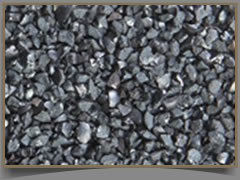About Blasting Grits
We are known for offering Blasting Grits that are widely demanded by buyers due to their quality. Our company takes the help of modern machines to design and develop the product, which reduces per-unit cost. We check the array on necessary parameters before dispatch because we are highly concerned about the quality of our offerings. Right from our very first business deal, we have been receiving appreciation from buyers for our Blasting Grits, which motivates us to work with the same excellence.
Efficient Surface PreparationOur blasting grits are engineered for optimal abrasive action. Their angular, granular shapes deliver enhanced cutting power, making them ideal for rust and paint removal as well as rigorous surface cleaning. Applicable on metal surfaces prior to coating or painting, these grits ensure superior adhesion and a clean substrate.
Reliable and Consistent QualityManufactured to standard industrial tolerances, these steel grits offer consistent performance with bulk density between 2.5 to 3.0 g/cm. Each batch boasts low chloride content (under 0.01%) and minimal conductivity, ensuring surfaces remain uncontaminated during and after blasting processes.
Long-lasting and VersatileWith unlimited shelf life when stored dry, our blasting grits can be used whenever needed, requiring no special storage conditions. Multiple grit sizes cater to diverse applications, whether coarse or fine blasting is required, making them a practical choice for wholesalers, dealers, and end users alike.
FAQs of Blasting Grits:
Q: How are these blasting grits typically applied to a surface?
A: These blasting grits are commonly applied using sand blasting machines, pressure blasters, or suction blasters. The angular or granular particles are propelled at high velocity to effectively remove rust, paint, and surface contaminants from a variety of substrates.
Q: What surfaces and applications are most suitable for these steel grits?
A: Steel blasting grits are primarily designed for cleaning and preparing metal surfaces. They are highly effective in surface preparation, rust removal, paint stripping, and improving the adhesion of coatings. Their varied sizes allow them to tackle both coarse and fine abrasive tasks.
Q: When is it recommended to use angular/granular steel grits over other abrasive types?
A: Angular or granular steel grits are best used when a rougher profile is desired for coating adherence or when quick material removal is essential. Their hardness (Mohs 6.07.0) makes them ideal for aggressive cleaning, especially on steel or large metal structures.
Q: Where can these blasting grits be purchased in India?
A: Blasting grits are widely available through dealers, distributors, exporters, manufacturers, retailers, suppliers, traders, and wholesalers across India. Orders can be placed for 25 kg or 50 kg HDPE bags, depending on your project size and requirements.
Q: What is the benefit of choosing grits with low chloride content and conductivity?
A: Low chloride content (less than 0.01%) and minimal conductivity (below 25 S/cm) ensure that treated surfaces remain free of contaminants that could lead to corrosion or coating failures. This makes the grits ideal for demanding industrial environments.
Q: How should these blasting grits be stored, and what is their shelf life?
A: It is recommended to store blasting grits in a dry environment to maintain their effectiveness. When stored properly, these grits have an unlimited shelf life, ensuring consistent performance whenever needed.
Q: What is the process for using steel grit in surface preparation?
A: The process involves loading the selected grit size into a compatible blasting machine. The machine then projects the grit onto the target surface, removing contaminants, rust, and old paint layers. The roughened surface is left ready for further treatment, such as priming or painting.

